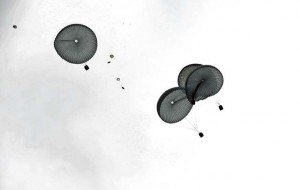
GRAFENWÖHR, Germany — Soldiers with the 21st Theater Sustainment Command’s 5th Quarter-master Detachment and 16th Sustainment Brigade joined to conduct aerial supply delivery training during an operation at the Bunker Drop Zone here May 23.
More than 12,000 pounds of water, which is used to simulate the weight of any supply item that can be dropped in a real-world scenario, was parachuted onto the drop zone on five separate pallets.
“This is as close as we can get to getting downrange and doing this at a forward operation area,” said Chief Warrant Officer Brian Martin, an air drops system technician with the 16th Sustainment Brigade. “If we were
doing a real-world mission, we could rig just about anything from medical supplies to food, water, beans, bullets — whatever we would need.”
Resupply is a big part of what they do, said 1st Lt. Christopher Carlstedt, a subsistence and water purification platoon leader with the 16th Sustainment Brigade’s 240th Quartermaster Support Company.
“A lot of times downrange, (supplies are) going to come via air drop, and this training ensures that we are capable of doing that,” he said.
Hands on preparation for the aerial supply delivery began a week prior with members of the 5th Quartermasters and 16th Sustainment Brigade rigging the palletized water with parachutes at Rhine Ordnance Barracks in Kaiserslautern in preparation for the drop.
Successful operations required accurate communication and logistics between all units involved in order to be mission ready and capable, Martin said.
“We have to make sure we can coexist and everyone gets the proper training,” he said.
Both the 16th Sustainment Brigade and the 5th Quartermasters conduct joint training on a monthly basis in order to be better prepared to conduct successful operations on the battlefield.
“Obviously, we don’t have the advantage of being in Afghanistan with the terrain or hostile environment, but we do have the capability,” Martin said. “As you do this, your muscle memory kicks in so that when you are in that hostile environment or in that forward support area, you will be able to conduct the mission as you did in the rear.”
“I think the more people that can get exposed to this and if we can get more training like this, it definitely sets up for better success for when we get downrange,” Carlstedt added.


